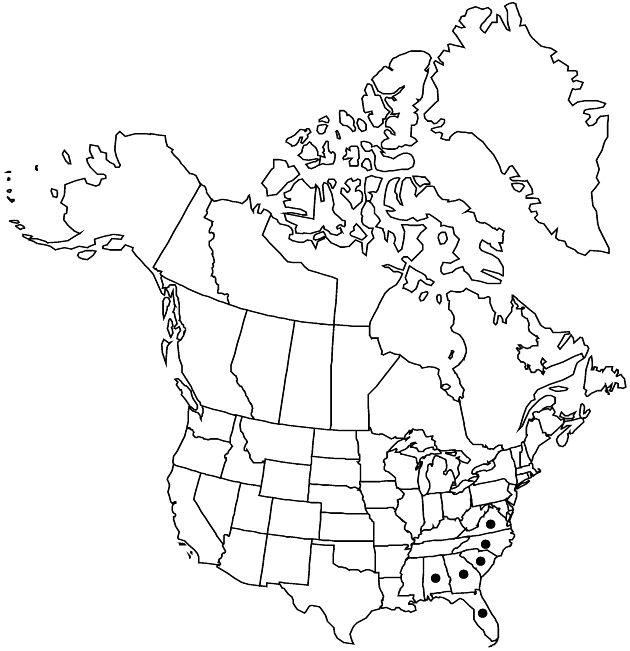Difference between revisions of "Marshallia obovata"
Biltmore Bot. Stud. 1: 5. 1901.
Basionym: Athanasia obovata Walter Fl. Carol., 201. 1788
Synonyms: Marshallia obovata var. platyphylla (M. A. Curtis) Beadle & F. E. Boynton Marshallia obovata var. scaposa Channell
FNA>Volume Importer |
FNA>Volume Importer |
||
| Line 7: | Line 7: | ||
|year=1901 | |year=1901 | ||
}} | }} | ||
| − | |basionyms={{Treatment/ID/ | + | |basionyms={{Treatment/ID/Basionym |
|name=Athanasia obovata | |name=Athanasia obovata | ||
|authority=Walter | |authority=Walter | ||
| + | |publication_title=Fl. Carol., | ||
| + | |publication_place=201. 1788 | ||
}} | }} | ||
|synonyms={{Treatment/ID/Synonym | |synonyms={{Treatment/ID/Synonym | ||
| Line 32: | Line 34: | ||
|elevation=100–1000 m | |elevation=100–1000 m | ||
|distribution=Ala.;Fla.;Ga.;N.C.;S.C.;Va. | |distribution=Ala.;Fla.;Ga.;N.C.;S.C.;Va. | ||
| − | |discussion=<p><i>Marshallia obovata</i> grows on the piedmont and on the Atlantic coastal plain. Scapiform plants with the leafy parts of stems less than 1/4 lengths of peduncles are sometimes known as <i></i>var.<i> scaposa</i>. They occur along the inner Atlantic coastal plain.</p> | + | |discussion=<p><i>Marshallia obovata</i> grows on the piedmont and on the Atlantic coastal plain. Scapiform plants with the leafy parts of stems less than 1/4 lengths of peduncles are sometimes known as <i></i></i>var.<i><i> scaposa</i>. They occur along the inner Atlantic coastal plain.</p> |
|tables= | |tables= | ||
|references= | |references= | ||
| Line 56: | Line 58: | ||
|publication year=1901 | |publication year=1901 | ||
|special status= | |special status= | ||
| − | |source xml=https://jpend@bitbucket.org/aafc-mbb/fna-data-curation.git/src/ | + | |source xml=https://jpend@bitbucket.org/aafc-mbb/fna-data-curation.git/src/f6b125a955440c0872999024f038d74684f65921/coarse_grained_fna_xml/V19-20-21/V21_1150.xml |
|tribe=Asteraceae tribe Heliantheae | |tribe=Asteraceae tribe Heliantheae | ||
|subtribe=Asteraceae (tribe Heliantheae) subtribe Marshalliinae | |subtribe=Asteraceae (tribe Heliantheae) subtribe Marshalliinae | ||
Revision as of 19:46, 24 September 2019
Plants 10–60 cm. Leaves mostly basal (distal slightly reduced); basal petiolate; blades 3-nerved, elliptic, oblanceolate, or spatulate, 5–10 cm × 5–15 mm. Heads 1–2, 20–30 mm diam. Peduncles 20–40 cm. Phyllaries 5–10 × 2–3 mm, apices obtuse. Paleae linear-spatulate, apices obtuse. Corollas white, lobes 2.5–6 × 0.5–1 mm. Pappi: scale margins entire or denticulate. 2n = 18.
Phenology: Flowering May–Jun.
Habitat: Understories, pine forests
Elevation: 100–1000 m
Distribution

Ala., Fla., Ga., N.C., S.C., Va.
Discussion
Marshallia obovata grows on the piedmont and on the Atlantic coastal plain. Scapiform plants with the leafy parts of stems less than 1/4 lengths of peduncles are sometimes known as var. scaposa. They occur along the inner Atlantic coastal plain.
Selected References
None.
Lower Taxa
None.